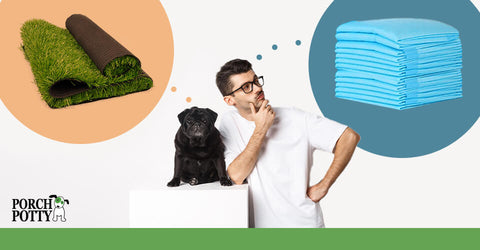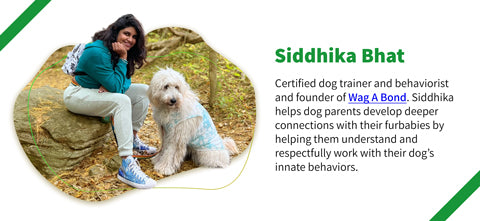
Dogs are highly adaptable mammals. Their instincts to choose surfaces to relieve themselves on combined with their ability to be trained to use a designated spot simplifies the process of toilet training to quite an extent and adds to the joy of raising and training them.
What influences a dog’s preferences when choosing a spot to eliminate?
Understanding the factors that influence a dog's choice of elimination spot can help you in training and managing their behaviour and also prevent accidents. Multiple factors may play a role in a dog deciding their preferred surface to relieve themselves, such as:
Familiar scent or the need to mark their own
Scents play a pivotal and an influential role in every dog’s life as they heavily rely on their sense of smell to interpret and navigate their environment, right from the time they are born. Dogs thrive on predictability and familiarity. This is primarily the reason why they prefer relieving themselves in areas where they detect familiar scents, especially their own. This familiarity provides them with a sense of calm and comfort.
Dogs have a tendency to get territorial in areas where they live or visit often. Several dogs may choose to mark their territory on surfaces frequented by other dogs as a way to claim it as their own or to communicate with other dogs. This may also be a deciding factor when dogs pick and choose surfaces to relieve themselves.
Environmental factors
Environmental factors such as weather, distractions, sounds, crowd etc. play an important role in influencing a dog’s preference towards a certain area. Toilet training a dog in the UK can have its fair share of challenges, especially with the unpredictable weather considerations. One of the most important things a dog needs when peeing or pooping is to feel at ease. Unfavourable weather, crowded environments, too many distractions and so on may only distract the dog further and act as hindrance in potty training.
For this reason, many dogs prefer relieving themselves indoors solely because of the calmness an indoor environment can provide. You may also notice that your dog may prefer to walk till an isolated spot in an outdoor environment to relieve themselves. Do keep this in mind if and when you need to transition your dog to an alternate designated spot.
Their existing routine and ease of access
One of the most absolute things about dogs is that they are creatures of habit. A consistent routine where they are exposed to a designated spot over and over again, frequently through the day can be a huge influencer in their surface preference. They are more likely to choose spots that they have frequented before rather than a new spot every single time.
Ease of access is also crucial in determining which spot/ surface your dog will eventually take to. If your dog has access to the full house but is expected to pee outdoors, it may be difficult for your dog to track the spot from different corners of the house. This may encourage them to keep having accidents on rugs and other areas of the house only because of how easily accessible these spots are.
Signs to Watch For
One of the best things about dogs is how clear and transparent they are with their body language cues. A dog’s body language never lies and is a clear give away in terms of their emotional state, physical state as also preferences. Once a dog has decided their preferred spot or surface to eliminate on, they will leave no stone unturned to let you know about it. Here are some behavioural cues and patterns to watch out for that will give you a clear indication on your dog’s preferred surface/ texture –
- They will keep going back to it over and over again
- If it is outdoors, they will wait till they reach that spot or surface to relieve themselves
- If it is indoors, they will feel the need to rush back home or patiently wait to eliminate on their preferred spot
- They will sniff excessively around that surface
- They seem at ease on or around that surface
- They may mark excessively on that spot
- This one is rare, but they may act territorial around that spot
- They will avoid sleeping, resting or eating on or around that area
- They will actively avoid eliminating in other areas or surfaces
- They are likely to have positive associations around that area

A long-coated fluffy yellow dog sniffs around a garden trying to find a good toilet spot.
Choosing an Ideal Surface for Your Dog
Designating a spot for your dog to eliminate themselves is a long-term commitment. It is important for this spot to be practical, easily accessible to your dog, easy to clean (if indoors) and away from hustle and bustle. Some commonly recommended surfaces for a dog toilet are:
- Real grass
- Artificial grass or a turf
- Pee pads
- Sand or mud
- Litter tray
Artificial turfs like Porch Potty are convenient options because of:
- How easily accessible they are to dogs indoors
- Ease of clean with one of their variants having a self-cleaning option
- Environment friendliness
- The surface almost feels like real grass which makes the transition process a lot quicker and smoother
Make sure to heap on positive reinforcement when trying to influence your dog’s preference towards a certain area or surface.
How to modify or choose a dog toilet that adapts to your dog’s preferences
Figure out your dog’s preferences then attempt to replicate the same experience on the new spot.
When potty training a puppy and choosing an ideal spot for them, taking their preferences into consideration will not only accelerate the training process, but will also give you fool proof and long lasting results. To do so, it is first important to thoroughly understand your dog’s preferences. Closely observe your dog around their pee/ potty time and make a mental note of the following:
- What kind of surface do they prefer?
- Are they reluctant to pee/ poop on any other surface?
- What are their pre- and post- toilet behaviours/
- Do they relieve themselves immediately or take their own sweet time?
- What is the environment of their existing designated spot?
Choosing a Dog Toilet
Similar Surface
It is important that the new toilet provides your dog with a similar (if not same) surface as they are currently accustomed to. An indoor turf like Porch Potty works well in this case because the fake grass patch feels quite like real grass. You have won more than half the battle in terms of potty training if your dog is comfortable on the surface of the new dog toilet.
Scent familiarity
Apart from the surface, scent is the next big thing that attracts the dog to keep coming back to the same spot over and over again. It is a part of the familiarity dogs crave in order to get accustomed to a routine. You can make your pup’s scent available on the new dog toilet by rubbing a pee pad or a paper towel on their pee and placing it on the new surface. The enzymes will encourage the dog to relieve themselves on it faster.
Create a favourable environment
The environment plays a major role in potty training a pup. Is your dog comfortable in an environment with some amount of hustle and bustle? Or do they need a little more privacy. Try to match the environmental settings of the new dog toilet to the existing designated spot to accelerate the transition process.

A black Chihuahua wits on its Porch Potty set up in the kitchen.
Training Tips
Consistent routine
Dogs thrive on a consistent and a predictable routine, especially when building new habits. Continued and frequent exposure to the new surface at the right time, i.e., when the dog needs to relieve themselves, can make a huge difference in changing the dog’s current preferences and getting them accustomed to the new one.
Make sure to take them to their new spot after meals, after they drink water, in between play times, after naps, first thing in the morning and last thing before they go to bed every single day.
Make the existing preferred option unavailable to your dog
If your dog is currently accustomed to peeing and pooping on surfaces like rugs or carpets in the house and you are in the process of discouraging these accidents, the first step to do so would be to temporarily get rid of all the carpets and rugs. Making these surfaces readily available to the dog will only increase the frequency of accidents on them, thereby making the transition process a lot harder. Reduce the likelihood of accidents as much as possible.
Make it incredibly easy for your dog
If the new designated surface is in one corner of the house and the dog is all the way in the other corner, it is going to be difficult for them to track it down. This will make them have an accident on the way, which will eventually translate into a habit. Make the new surface easily accessible to your dog. This may initially mean restricting your dog’s access or blocking off other areas of the house temporarily to prevent accidents. Ease is crucial for your dog to effortlessly adopt a new habit/ routine.
Positive reinforcement is key
Closely monitor and reward smallest of wins in the process of transitioning your dog to the new spot. You will face resistance in the initial phase of training, but continued positive reinforcement and consistent training can make a great deal of difference. Take a step back as and when needed and make sure to closely monitor your dog to mark and reward every desirable behaviour along the way.
Replicate the old experiences on the new spot
Some dogs may have a tendency to engage in play or other kind of behaviours before and/or after relieving themselves. Allow your dog to engage in similar behaviours around the new spot. This will give your dog a sense of familiarity and accelerate the transition process.
Prevent accidents to the best of your ability
The more a dog practises a behaviour, the better they get it. This applies to desirable as well as undesirable behaviours. If your dog ends up having accidents repeatedly day in and day out, training them to go towards their new designated spot will be a challenge. Make sure to prevent accidents to the best of your ability. If this means making the current surface unavailable, monitoring the dog more closely than ever before and micromanaging their environment, so be it.
When training a dog, it is crucial to train at their pace, respect their boundaries and take into consideration their preferences. This will not only make training a joy for your dog, but will also give you fast, positive and long-lasting results. Understanding their preferences will help you eliminate the likelihood of mistakes and accidents in the training process. So, on what surface does your dog’s preference lie? Let us know in the comments below!
Siddhika Bhat, certified dog trainer and behaviourist and founder of Wag A Bond.
For more information on training your dog, check out these articles:




